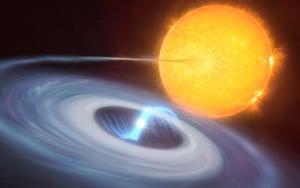Celebration of Space - June 7, 2024

A nova that occurred in Sagittarius during 2015. Image credit: Frosty Drew Astronomy Team member, Scott MacNeill.
Back in March, we wrote about the prospects of a naked eye visible nova in the constellation Corona Borealis (CrB) involving the very dim star T CrB. That was nearly three months ago, and half of the time given for the nova to likely occur. Well we still haven’t seen it and the window is shrinking, making for an increased likelihood of it happening soon. The nova is slated to occur anytime from now through September. So, what is a nova?
A nova occurs when one of two stars that share a common center point of gravity, called a barycenter, dies and collapses into a white dwarf. A white dwarf is the dead core of that star which is now exposed to space. It is about the size of Earth with the mass of the Sun. When the star dies, a significant amount of mass is released into space, which changes the gravitational relationship that both stars share. This can result in the white dwarf assuming a highly elliptical orbit around the barycenter. When this happens the white dwarf will orbit much closer to the star that is still active. If the orbit crosses the Roche Limit – which is the distance that the gravity of one object can overcome the gravity of another object tidally, then the white dwarf will start to steal mass from the active star during these close encounters. This is called accretion, and the matter that is accreted is largely hydrogen.
So now you have a dead star that is mostly comprised of carbon and oxygen which is gathering hydrogen on its surface. The more hydrogen that the star gathers, the more mass the star has. This increase in mass starts to increase the temperature of the white dwarf. Eventually, the mass of the star will reach 1.44 times the mass of the Sun, which will trigger hydrogen fusion. But instead of this happening in the core of an active star, where it takes over 100,000 years for the resulting light to reach the surface, it all happens instantaneously on the surface of the white dwarf. The resulting explosion will blast all of this accreted hydrogen off the star as it is fusing. When this happens the brightness of the star will increase thousands of times for a very short period, usually about 1-2 weeks time.
As violent as this sounds, it is actually a rather elegant process. Both the white dwarf and the active star will survive the event, and the cycle will start over again. The last time T CrB produced a nova was in 1946 and the same behaviors that preceded that nova have all largely occurred again. Sky watchers will notice the nova as a star that appears in the constellation Corona Borealis that was not there the day before. Corona Borealis is the Northern Crown and appears as an arc of stars, I see it like a big coma in the sky, that resides between the constellations Hercules and Bootes. Alphecca is the brightest star in Corona Borealis. Using Alphecca, observe the two stars eastward next to Alphecca. These three stars will form nearly a straight line, follow that line eastward past the last star, about the same distance as the space between each star. That is where T CrB resides. Normally this star is well beyond naked eye visibility. If you look at this spot and see a star that is nearly as bright as Alphecca, then the nova has occurred.
When this nova occurs we will send out an announcement as a heads up. The nova will wane very quickly, and won’t happen again for another 80 years. Here is a finder chart to help with the location of T CrB.
After a bit of a lull in space station pass activity, China’s space station – Tiangong has returned to the evening sky offering several visible passes over the next week. Here are some of the more notable passes:
Fri, Jun 7 at 10:21 pm, starting in the W, rising to 85º, heading towards the E, and into orbital sunset ← Amazing pass!
Sat, Jun 8 at 9:21 pm, starting in the WSW, rising to 73º, heading towards the E ← Amazing pass!
Sun, Jun 9 at 9:58 pm, starting in the W, rising to 88º, heading towards the E, and into orbital sunset ← Amazing pass!
Mon, Jun 10 at 8:57 pm, starting in the W, rising to 85º, heading towards the E ← Amazing pass!
Mon, Jun 10 at 10:34 pm, starting in the W, rising to 60º, and into orbital sunset ← Amazing pass!
Tue, Jun 11 at 9:34 pm, starting in the W, rising to 82º, heading towards the E, and into orbital sunset ← Amazing pass!
Wed, Jun 12 at 10:11 pm, starting in the W, rising to 47º, and into orbital sunset.
Thu, Jun 13 at 9:10 pm, starting in the W, rising to 66º, heading towards the ESE, and into orbital sunset ← Amazing pass!
Look at that list of amazing passes! Tiangong has grown quite large and is currently just under half the size of the International Space Station. Since Tiangong is modular, China can double its size when needed. This makes Tiangong very visible when it passes over. Not as bright as the ISS, but close. So take some time this weekend and coming week to step outside and see one of the two space based residences that humanity has created, and give it up for these engineering marvels. You can follow along with daily visible pass predictions of the stations at Frosty Drew.
- Author:
- Scott MacNeill
- Entry Date:
- Jun 7, 2024
- Published Under:
- Scott MacNeill's Columns




